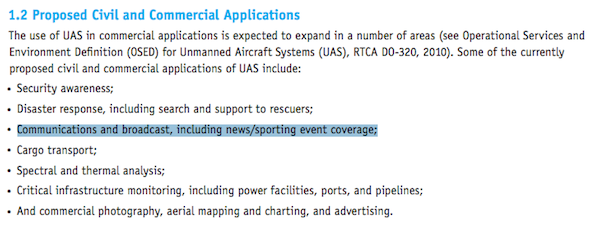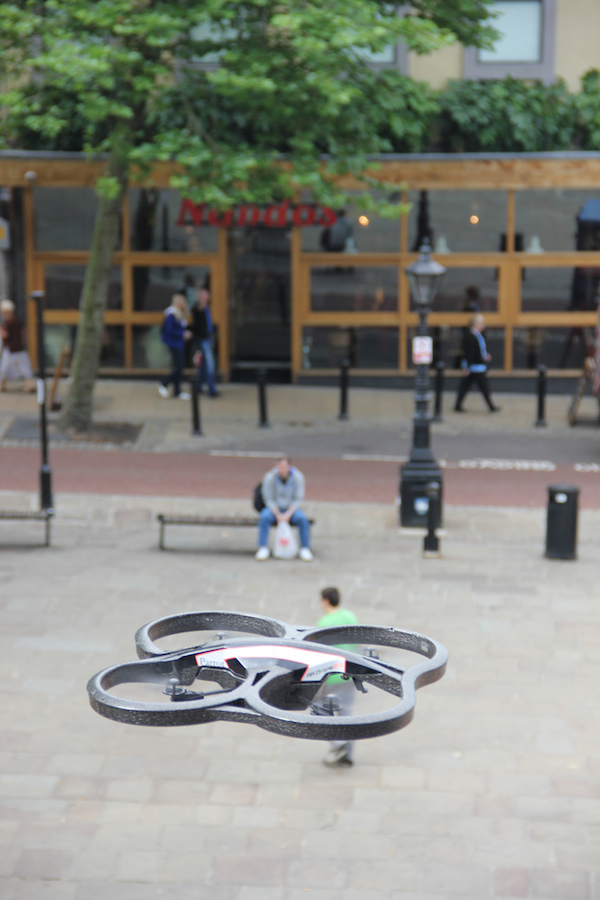Editor’s note: If you’ve been at a journalism conference over the past year — or stood near the right Midwestern riverbed at the right time— you’ve probably heard about drone journalism. That’s the idea that small unmanned aerial vehicles can be useful as a reporting tool. But the law around the peaceful use of drones — for journalism or any other purpose — is still fuzzy, which led to two j-school drone programs being shut down this summer.
Clarity on the way, though, and in this post — originally published at the University of Nebraska’s Drone Journalism Lab — Lab founder Matt Waite tries to decode what the new rules might look like.
 Last week, the Federal Aviation Adminstration released a document called the Integration of Civil Unmanned Aircraft Systems (UAS) in the National Airspace System (NAS) Roadmap. In it, the FAA lays out what it intends to do in the near future when it comes to UAS in the NAS — drones in the sky.
Last week, the Federal Aviation Adminstration released a document called the Integration of Civil Unmanned Aircraft Systems (UAS) in the National Airspace System (NAS) Roadmap. In it, the FAA lays out what it intends to do in the near future when it comes to UAS in the NAS — drones in the sky.
So what does it mean for drone journalism? Based on a quick read, here’s what I see:
- The vast bulk of the document is about much bigger and more sophisticated aircraft than journalists will need for the vast majority of applications. The document is mostly about big planes with very sophisticated ground stations intermingling with manned aircraft at high altitudes. Most applications of drone journalism don’t require large aircraft flying high.
- The FAA is aware that journalists want to use drones/UAS/UAVs. Page 7, section 1.2, in a second called Proposed Civil and Commercial Applications, number three in the list is “Communications and broadcast, including news/sporting event coverage.”

- Journalists should be on the lookout for something called a Notice of Proposed Rulemaking (NPRM) for sUAS, or small unmanned aerial systems. The types of devices and the level of sophistication most available to newsrooms falls under this sUAS category — smaller than 55 pounds and with limited range and altitude. From the document: “The sUAS NPRM is expected to be released in early 2014.”
- Journalists wishing to use drones will most likely have to record safety data and report it to the FAA. “Data collection will expand when additional agreements are finalized for sharing public UAS data and new rules and associated safety data reporting requirements are implemented for sUAS.”
- What will the rule-making process for small systems involve? “…the classification of sUAS, certification of sUAS pilots, registration of sUAS, approval of sUAS operations, and sUAS operational limits.” Journalists should be wary of language like “approval of sUAS operations” for issues of prior restraint. The government’s approving or denying specific stories has been routinely found to be barred by the First Amendment. However, content neutral restrictions with a stated safety purpose have withstood court challenge. (Think shouting “fire” in a crowded theater.) Just what “approval of sUAS operations means” will be critical to journalists wishing to use drones.
- There will be a public comment period for these rules, and journalists and journalism organizations should take part in it. If you or your news organization believes they may one day use a drone to report news, you’re going to want to pay attention to this and get involved. Also, tell your journalism organizations to get involved too. Remember: The FAA said they’ll start the process in early 2014.
- The sUAS rules will most likely mean drone journalists will not need certificates of authorization (COA) from the FAA. “When the final rule is published and in effect, it will reduce the need for sUAS operators to conduct operations under either a COA or the constraints of an experimental certificate. This will allow operators and the FAA to shift the focus of resources to solutions that will better enable UAS integration.”
- It will not be a free-for-all under new sUAS rules. “Operations of sUAS under new regulations may have operational, airspace, and performance constraints, but will provide experience for pilots and additional data to inform subsequent rulemaking, standards, and training development for safe and efficient integration of other UAS in the NAS.” Also, this is worth watching: “As integration begins, there will be approved airspace and procedures for sUAS, which will provide a basis for developing plans for increased NAS access as UAS are certified.” That could mean a simple altitude ceiling (say, 400 feet) or it could mean the current system of “forget flying in a city” or something between the two. It’s worth watching when the rules come out.
- You’ll probably need a license and undergo a background check to fly a drone commercially. “Goal 1: FAA certification requirements for pilots and crew members for sUAS classes (including medical requirements, training standards, etc.) published as part of a sUAS rule by 2014 in accordance with the FMRA [FAA Modernization and Reform Act of 2012]. Note: These requirements include coordination with other government agencies on security/vetting requirements.”
So the document really just gives hints as to what’s to come for legal drone journalism in the US. But that’s more than we’ve had up to now. In short: Heads up in the New Year.
Photo of a hovering drone by John Mills used under a Creative Commons license.

 Last week, the Federal Aviation Adminstration released a document called the Integration of Civil Unmanned Aircraft Systems (UAS) in the National Airspace System (NAS) Roadmap. In it, the FAA lays out what it intends to do in the near future when it comes to UAS in the NAS — drones in the sky.
Last week, the Federal Aviation Adminstration released a document called the Integration of Civil Unmanned Aircraft Systems (UAS) in the National Airspace System (NAS) Roadmap. In it, the FAA lays out what it intends to do in the near future when it comes to UAS in the NAS — drones in the sky.